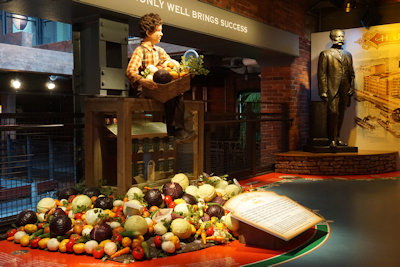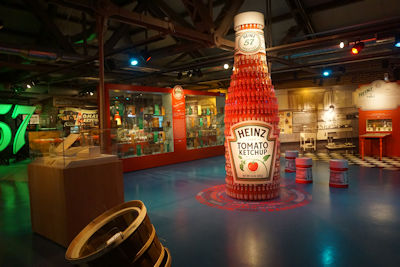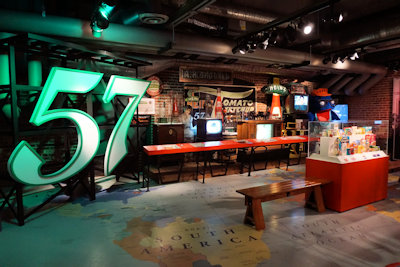
During the late nineteenth century, Pittsburgh was home to three titans of industry who played major roles in not only the development of the city but the nation’s as well. There was Andrew Carnegie, who ruled the steel industry; George Westinghouse, who made railroad travel safer with his braking system and brought electricity to the masses; and H.J. Heinz, who revolutionized the food industry with a plethora of products ranging from horseradish to pickles to ketchup.
The legacy of the H.J. Heinz Company goes beyond its manufacturing abilities, however, and a permanent exhibit at the Senator John Heinz History Center uses both historical artifacts and video chronicles to demonstrate the true impact of the food processing giant on contemporary society.
“By the time of his death in 1919, H.J. Heinz’s company had grown into one of the largest food processing businesses in the nation, selling its condiments, sauces, pickles, and preserves all over the world,” the exhibit explains. “The Heinz recipe for success included the following ingredients – a growing market for prepared foods, an innovative spirit, a wide variety of products, commitment to quality, abundant and creative advertising, and enterprising sales techniques.”
Although the early childhood of H.J. Heinz and the birth of his company are recounted, the History Center places a majority of its emphasis on the above “ingredients,” showing how Heinz influenced more than just the way we purchase ketchup.
The exhibit opens with a life-like figure of H.J. Heinz as a young boy holding a bushel of vegetables with an image of his childhood home in the background. Heinz began tending a garden outside the house at the age of twelve and started selling produce from it to local grocers, along with jars of his mother’s horseradish. From those small beginnings, Heinz built an empire, but it took more than just hard work and tenacity – it also took insight and vision.
The adult H.J. Heinz realized that as the United States became more urban and industrialized, Americans would begin to rely on store-bought products as opposed to the homemade and homegrown. The advent of refrigeration, railroad transportation, and manufacturing technologies, meanwhile, provided the opportunity for a company like Heinz to expand and flourish. The Heinz History Center notes that while there were over 800 different brands of ketchup available in 1915, only Heinz remains as a global corporation in the twenty-first century.
The story of H.J. Heinz is thus more about the person but how that person reinvented an entire industry as well. Heinz was able to “think outside the bottle” as he envisioned unique ways to both market and sell his products. Clear glass containers were used, for instance, in order to display the quality of the products contained inside.
Having once been a young boy who sold his garden vegetables directly to the local grocer, meanwhile, Heinz used the same technique as an adult by building a sales force that traveled the country with sample cases and bypassed middleman wholesalers. Even after securing a store’s business, these salesmen continued to visit the establishment, introducing new products, removing expired items, and constructing unique displays for Heinz products in their store windows.
H.J. Heinz also saw a market for his products in diners, restaurants, and hotels, and sent his salesforce to those establishments. The company likewise expanded its product line to meet changes in American eating habits. As “convenience” began to dominate both domestic kitchens and public eateries, the H.J. Heinz Company began marketing soups and baked beans. When fast-food chains gained in popularity during the 1960s, Heinz again adapted by developing single-serve ketchup packets.
Advertising was another key component of the Heinz strategy and went beyond magazine and newspaper advertisements. The first electric sign in New York City – and the largest in the world at that time – was constructed by H.J. Heinz in 1900. Two years earlier, the company leased a 1,000-foot-long pier in Atlantic City that allowed visitors to send free Heinz postcards, sample products, and hear presentations on the company.
H.J. Heinz also relied on World Fairs to get his message of quality foods to the masses. The most famous was the 1893 World’s Columbian Exposition in Chicago. The company was allocated space far from the main attractions of the expo, so Heinz printed thousands of fliers offering a free souvenir and scattered them over the fairgrounds. The souvenir was a pickle charm that eventually transformed into the still popular pickle pin.
Then there was the trademark 57 logo of the Heinz Company. “Why 57?” the Heinz History Center exhibit asks. “As the story goes, H.J. Heinz created the Heinz 57 trademark after spotting a sign advertising ‘21 Styles of Shoes’ while riding an elevated train in New York City in 1896. Captivated, he decided to advertise Heinz products in a similar way. Heinz began counting and stopped at 57, even though the company made many more products, because he liked the way it sounded.”
All the advertising in the world would have meant nothing if it wasn’t for the quality of the product inside the bottle, and both H.J. Heinz and the company he founded placed an equal emphasis on that quality. Specialty seeds were developed in order to grow a better tomato, for instance, and contracts with farmers mandated that produce be delivered to a processing plant the same day it was harvested.
By 1910, Heinz had plants across the country and even expanded across the globe, but the original factory in Pittsburgh’s North Side remained the model of efficiency. Years before Henry Ford invented the first automobile, the assembly line manufacturing process had already been incorporated into the Heinz Factory. Engineers from around the world would visit Pittsburgh to study and learn from the facility.
“In 1869, 25-year-old Henry John Heinz planted the seeds of his pickling empire,” the Senator John Heinz History Center declares. “From one young man’s entrepreneurial spirit came the global corporation that continues to bear his name and legacy. Beginning with less than an acre of garden in the small town of Sharpsburg, H.J. Heinz and his successors built an international food business that retains many of the core values that guided its founder. The story of the company’s growth is a story of food, industry, and culture – of the role Heinz the man and Heinz the company have played in shaping our tastes, developing new products and markets for food, and bringing change to our dining table.”
That story is brought to life at the Senator John Heinz History Center in a permanent exhibit that includes an eleven-foot ketchup bottle composed of more than 400 actual Heinz bottles stacked on top of each other. In many ways, it is a fitting tribute to one of the three great titans of industry who called Pittsburgh their home during the late 1800s.
Anthony Letizia





